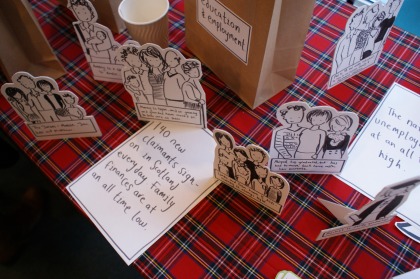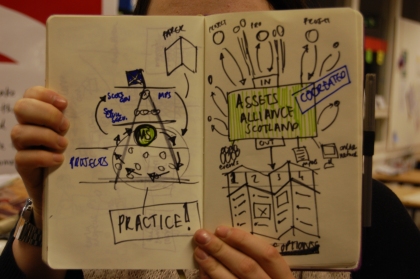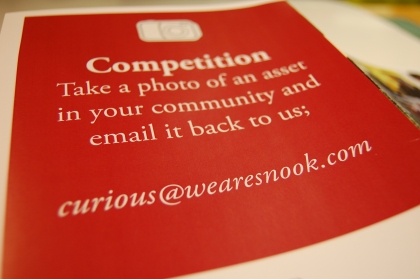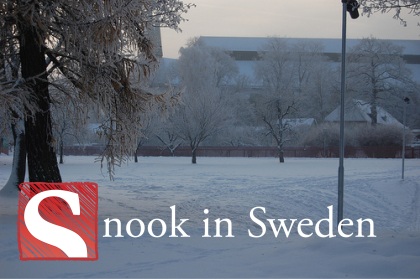Filed under: event, inspiration, interesting, Public Sector Design, service design, social innovation, Transformation Design, work | Tags: alliance, asset, change, design, glasgow, gov, government, health, nhs, public, scotland, scottish, sectir, transformation
This morning Snook were kindly invited to take part in Assets Alliance Scotland, an event being jointly held by the Scottish Government, Scottish Community Development Centre and the Long Term Conditions Alliance Scotland.
“We in Scotland should be proud of our tradition of community involvement and community action and public service delivery’s role in supporting this activity to flourish. However, in the last few years we have developed a model of public service delivery based on a ‘treatment’ or ‘doing to’ approach, which often fails to recognise communities’ and service users’ own strengths and assets and which instead engenders a culture of dependency that, in turn, stimulates demand.”
Before attending the event, I had made a clear connection in my head about how closely this aligned with the work of Liz Sanders.
“Designers will no longer only design for people, they will learn
to design with people. Co-designing will require new forms of
communication to support the collective creativity that arises between
designers and everyday people.”
Working with frontline staff and users as the experts in their own eco-systems/services is a big part of the work I am doing right now. I bring their thoughts and imaginings to life. We take the most optimistic stance we can; an issue can always be solved, there are assets all around us that help to solve a problem or build a brighter future.
The morning was kicked off with Harry Burns, who a participant described his delivery as ‘not usual for a Scottish gov type’. Perhaps, he was right. It was fantastic and inspiring to hear someone talk about a ‘social movement’ rather than a new set of targets or paper/policy being delivered from the government. What really caught my attention was Dr Burn’s citing of the great union activist, Jimmy Reid. Reid’s inaugural speech as rector of Glasgow University in 1972, has really influenced Snook, ( hat tip to Mike Press who highlighted this speech during his keynote at Create Debate.
“A rat race is for rats. We’re not rats. We’re human beings. Reject the insidious pressures in society that would blunt your critical faculties to all that is happening around you, that would caution silence in the face of injustice lest you jeopardise your chances of promotion and self-advancement.
This is how it starts, and, before you know where you are, you’re a fully paid-up member of the rat pack. The price is too high”
“It’s the frustration of ordinary people excluded from the processes of decision-making. The feeling of despair and hopelessness that pervades people who feel with justification that they have no real say in shaping or determining their own destinies.”
Interestingly Dr Burns steered clear of the Big Society agenda and favored the words of Jimmy Reid. This line always brings it home for me;
“A rat race is for rats. We’re not rats. We’re human beings”
Sometimes I feel a deep sigh coming on as I soldier through different public sector systems, hoops, and documents. I think sometimes we forget, at the end of the day, we’re all people.
On the people side, after the keynote, participants were invited to browse projects which linked with an asset based approach. I showcased the Getgo Glasgow project and how we mobilised a community to see past their issues and ‘obvious’ solutions to problems in their community. I talked to participants about the power of visualisation and an optimistic mindset. I also showcased other pieces of work such as the Future Library Project and the Innovation Cards.
To add more detail to the visionary approach of Dr Burns, Andrew Lyon of the International Futures Forum set the task of imagining what Scotland’s Asset Alliance priorities should be – what actions need to be taken and what are matters of urgency.
It was an interesting discussion. Andrew graciously let everyone voice their opinion at the end of the event. The discussions taught me that we need a framework to house some of this work and break it down into how to ‘do asset based work’. It was obvious that there is already a huge amount of asset based work being done, and it has a history. Perhaps, it’s not always under the label of an ‘asset based approach’ but known as ‘community development’. I’m not saying we ‘teach a granny to suck eggs’ as one participant in my group warned against, but we create a menu of options which breaks down an asset based approach, a framework to house the knowledge gathered through the AAS which is easy to access, understand, share, and importantly learn from and put into practice. For example, a range of options on how to engage with people in communities and connections to people who are experts in this field would be beneficial.
The group deliberated between a top down approach, and whilst I agreed that you need government buy in, I think the last thing that is needed is another strategy/policy document on an asset approach that promotes meaningless, tick box targets. If we’re going to talk targets under the assets agenda, then I think we need to think really carefully how that is conveyed.

Technology curve of adoption
I felt that we could look at the curve of adoption for technology and think about how ‘early adopters’ are the users who begin to write the ‘playbooks’ and ‘how to guides’. Perhaps the AAS would take this role on board and begin pulling together existing networks and organising information.
I noticed the Alliance pulling together ongoing work, and past work, branding it as ‘Assets based’ to build a community of practitioners in Scotland, and develop a framework to house this knowledge. However, I did mention there is a huge need for more interaction across different sectors. Some of the conversations around ‘person-centeredness’, ‘co-creation’ and ‘assets’ are not only relevant to health but to everyone. Our lives are are a holistic combination of services and complex interactions that overlap different sectors on a daily basis.
Importantly, as a chameleon amongst different sectors, this kind of work and demand-led idea is appearing across all sectors, not just health. Take Skills Development Scotland 2010-2011 Corporate strategy, an organisation I worked alongside last year. They talk multiple times over about co-creation and demand-led services, which I think align closely with asset based and coproduction movements and murmurs going on around our country.
The most poignant thought for me at the end was about listening. A participant talked about asking others what assets mean to them and learning from this feedback. This struck a chord with me and I was happy that Snook had given out a small task for participants to capture assets in their community and email the photos back to us. We’re looking forward to peering through them and posting them online, feel free to get involved even if you didn’t pick up a leaflet.
Finally, the reason for this task, and what gets me every time at events like this is the need for a vision. Andrew Lyons had asked us what the AAS will ‘look’ like, yet I saw no hint of visual thinking or communication. This goes deeper than graphically facilitating the discussions that were taking place but the way in which we go forward in discussing the future of the AAS, and the approach we use in the future for the development of our public sector and country.
We need to share projects, the how to, and do it visually. A picture speaks a thousand words and breeds a common understanding which if applied in context of the AAS could mean a shared vision for the meaning of assets, the alliance, and perhaps as Pat Kane called for at Political Innovation camp a few weeks ago, a shared vision for our country. Big talking, but, something keeps hitting a nerve of late at discussions like this. Words like transformation seem to be super seeding ‘change’, ‘improvement’, ‘efficiency’, It feels there are some big ‘shake ups’ that need to happen. With Andrew asking us about urgency today for the AAS, something niggles me even more. I have a feeling the time is now, we need to move fast.
Filed under: event, Public Sector Design, service design, social innovation, Transformation Design, Uncategorized, work | Tags: conference, design, organisation, servdes, service, servicedesign, snook, sweden, transformation
Another Snook adventure under our belt ; this time in Linkoping, Sweden. The occasion? Servdes. Traveling through some thick snow I made it to the conference, this time under the theme of Exchanging Knowledge.
“The Nordic Conference on Service Design and Service Innovation, ServDes, is the premier research conference for exchanging knowledge within service design and service innovation…Service design as a field has established itself as a strong discipline, through efforts in practice and academia. However, publications have mainly focused on establishing service design. There is a growing need for original research on service design. The ServDes conference is an answer to this call…”
In short, it was in-depth and fun. Making it the best event I have taken part in this year. However, I struggled with the delicate balance between practitioners and researchers. This was a recurring theme in some of the discussions I had about academia and practice can can link up and communicate better. As an active practitioner, I’ve just left academia ; finishing a Masters on Embedding design in the public sector which was more action research and reflection than it was academic. For me, this works, because at the end of the day, I want to make change happen. Personally, I’d rather work with academics to document and theorise the work I do on the ground. I’m wondering if Servdes will become the catalyst for making this connection smoother?
Snook were invited to present the case ‘Service Design: social innovation is our motivation’. The presentation reflected on a project, Getgo Glasgow, undertaken last year at the Glasgow School of Art. It depicts some of the issues the design community is facing when undertaking social design/innovation projects within design education. My presentation considered some of the shortfalls in the project ; time frames, delivery and ethics. How do designers leave a project like this ethically? Have we considered the consequences of sending young designers out to engage with communities/users. A film is on the way but for now, you can view the presentation.
The presentation aligned with Don Norman’s views published on Core 77: ‘Why Design Education Must Change‘.
“Many problems involve complex social and political issues. As a result, designers have become applied behavioral scientists, but they are woefully undereducated for the task”
This brilliant yet critical article picks on design education for producing undereducated designers who are ‘woefully ignorant of the deep complexity of social and organizational problems.’ In the case of GetGo, the community now have money in the bank and the project is really happening. Wyndford, where the project took place, is small area that are now mobilised as a community. We designed a process not necessarily a designed solution. The result ; Green Gorillaz wasn’t really designed, it was a half baked idea which was the bi-product of design methods and skills being used to work co-creatively with a community.
My presentation actually sparked some interesting conversations about interdisciplinary work, collaboration and the reality that designers are not experts in everything. It pays to know when and how to ask for help. The question and answer session revealed that students struggle with some elements of this type of project. For example, being equipped with the skills and know how to create intangible outcomes that are implementable. This is something we are aiming to get to grips with through our venture: Making Service Sense.

Highlights for me included Daniela Sangiorgi’s talk(s) on ‘Transformative Services and Transformation Designbuilding‘. It looked at building capabilities inside organisations to use and understand design to produce better services. This was an area I felt was overlooked in Berlin at the SDN10 conference and was only just touched upon by Philips. It mimics efforts made by Engine in their Hoop model and echoes sentiments from Martin Neumier’s Designful company which I reflected on for the last 12 months with a public body in Scotland on how to really use design thinking to create better services for the people of Scotland and more informed, people centered policy.
What Daniela put forward echoed closely with some discussions from the workshop run by Anna Serevalli and Anders Emilson. They held a workshop on Social Innovation which looked at the criticisms and plaudits by Geoff Mulgan of design in social innovation. Some of the points our group discussed were;
- Design(ers) should be a-political
- We need to create designful organisations and transform thinking
- We should look to open source community for inspiration
- We should be pushing for delivery and implementation
- Designers are facilitators not experts
Eva-Maria Hempe followed some of the capabilities discussion with, ‘Health and social care services for people with complex needs: The role of contextual knowledge for the design process’ and showcased a really interesting project. More interestingly for me, was the pyramid at the end of her slides on Design capacity versus Design obstacles which I’d like to look more into and see designers considering this.
There were other really good presentations, far too many to mention, in short, a couple more were Marc Stickdorn’s presentation on students and tourism, showcasing how quick and effective service design can be. Also, Simon Clatworthy’s talk on Touchpoint cards was to the point and got some cogs turning about how we could use the template as a basic model to create our own more personalised cards for say tourism, or methods in Service design.
Finally, to end the conference, Global Service Jam was launched by Markus Edgar and Adam St john. It will bring together different countries from all over the world next year to develop new services in under 48 hours and then share them online. They’ve had a fantastic response already and if you want your country to be part of it, then I suggest you get in touch with them.
And not forgetting the unconference day, organised by Design thinkers ; an impromptu, insightful and busy day of talking, doing, and drinking coffee.

I ran a workshop called #swesno, which looked at using design thinking and methods to tackle social issues caused by Snow in Sweden. Wearing santa hats, to get us all in the mood, one group tackled loneliness and isolation with the opportuniy of untapped engergy of kids playing outside in the snow, whilst the other group looked at the issue of ambulances getting stuck in the snow. There will be a another blog post to follow on the outcomes of the workshop. The storyboarding method and pushing people as a vehicle through a new service design worked incredibly well, and took a group of participants 3 hours. They started from scratch, developing and blueprinting new service concepts which the Swedish authorities could implement.
The day capped off with the launch of This is Service Design Thinking. If you haven’t purchased it, do it. It is a very comprehensive textbook which has been co-created by the design community. I am very happy for the authors and am sure both Jakob Schneider and Marc Stickdorn are relieved to see their hard work come to fruition.

To wrap up, these conferences aren’t always just about the learning but are also about the friends you make. It was lovely to make some new European and continental friends and catch up with old ones. It never ceases to amaze me how friendly, open and collaborative the Service Design community can be. Snook are humbled to be part of it.
Huge thanks to Fabian and the rest of the Serv Des team for making this event possible.
Here’s to next year and bigger and better snowball fights...






